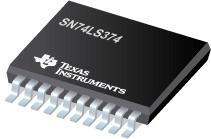●These 8-bit registers feature 3-state outputs designed specifically for driving highly capacitive or relatively low-impedance loads. The high-impedance 3-state and increased high-logic-level drive provide these registers with the capability of being connected directly to and driving the bus lines in a bus-organized system without need for interface or pullup components. These devices are particularly attractive for implementing buffer registers, I/O ports, bidirectional bus drivers, and working registers.
●The eight latches of the LS373 and S373 are transparent D-type latches, meaning that while the enable (C or CLK) input is high, the Q outputs follow the data (D) inputs. When C or CLK is taken low, the output is latched at the level of the data that was set up.
●The eight flip-flops of the LS374 and S374 are edge-triggered D-type flip-flops. On the positive transition of the clock, the Q outputs are set to the logic states that were set up at the D inputs.
●Schmitt-trigger buffered inputs at the enable/clock lines of the S373 and S374 devices simplify system design as ac and dc noise rejection is improved by typically 400 mV due to the input hysteresis. A buffered output-control (OC) input can be used to place the eight outputs in either a normal logic state (high or low logic levels) or the high-impedance state. In the high-impedance state, the outputs neither load nor drive the bus lines significantly.
●OC\ does not affect the internal operation of the latches or flip-flops. That is, the old data can be retained or new data can be entered, even while the outputs are off.
● Choice of Eight Latches or Eight D-Type Flip-Flops in a Single Package
● 3-State Bus-Driving Outputs
● Full Parallel Access for Loading
● Buffered Control Inputs
● Clock-Enable Input Has Hysteresis to Improve Noise Rejection (S373 and S374)
● P-N-P Inputs Reduce DC Loading on Data Lines (S373 and S374)



